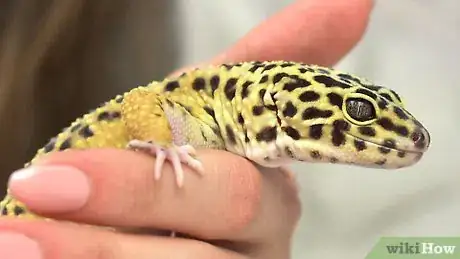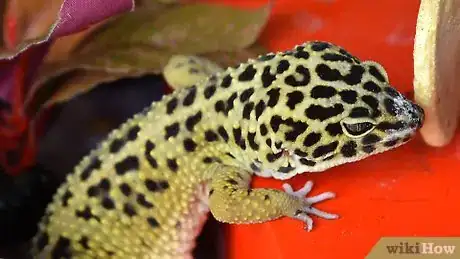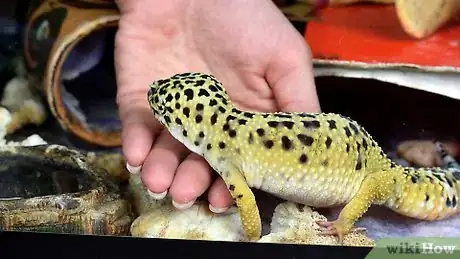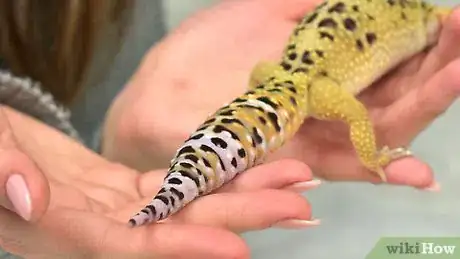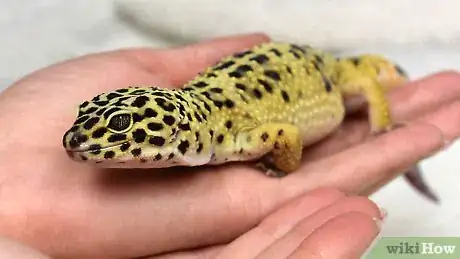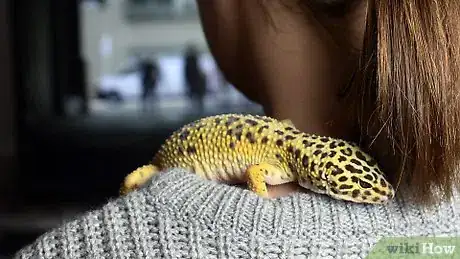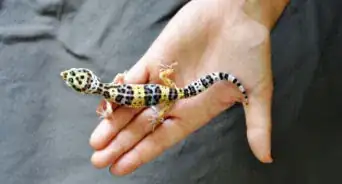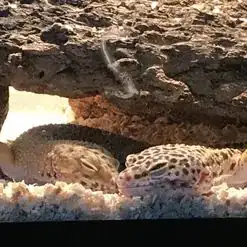This article was co-authored by Audra Barrios. Audra Barrios is a Marine Biologist and owner of Lick Your Eyeballs, a business offering experiemces, reptiles, supplies and plants. With over 15 years of experience, Audra specializes in reptiles and exotic animals, environmental education, marine biology, conservation issues, and animal husbandry. Audra earned a BASc in Marine Biology from the University of California, Santa Cruz, and studied Natural Sciences at the College of Marin. She is the founder and Executive Director of Things That Creep, a non-profit dedicated to herptile conservation through education. She has spent the last nine years working as a biologist at the California Academy of Sciences.
wikiHow marks an article as reader-approved once it receives enough positive feedback. This article received 48 testimonials and 100% of readers who voted found it helpful, earning it our reader-approved status.
This article has been viewed 701,138 times.
Beloved for their spotty scales and sweet personalities, leopard geckos are just the best. Now that you have your lizard all set up in it's cage, you're probably thinking: alright, let's have some fun! There are tons of easy ways to bond with your lizard, and we're walking you through them all below. Let's get started.
Steps
Handling & Playing Basics
-
1Start handling your gecko when it is young. When you first buy your leo, it will need some time to adjust to its new home. Let it sit in its tank for max a day unless it's very stressed, then give it some more time so it can explore and get comfortable. Don’t feel bad if, once it checks out its home, it doesn’t come out of its favorite hiding spot for a while. Having said that, the earlier you familiarize yourself with your gecko, the better, as geckos who are handled and played with at a young age are generally much more calm and loving when held at a later age.
- An ideal age to begin playing with your gecko is when it is five to six months old, but any age that it is comfortable with humans is good as long as it's not still a hatchling.
- Keep in mind that leopard geckos don't particularly like being held. If you get your leo used to being handled when it's young, it probably won't mind when you hold it, but it won't love it either![1]
-
2Understand that your gecko might be a little creeped out by you. In the wild, anything as large as we are would be considered a threat by any lizard. So don't feel bad if your gecko takes a little while to warm up to you.
- Don’t rush your gecko. If you are antsy to begin handling and playing with your gecko, comfort yourself by learning all about your leo. When you set up its home, set up hiding places that your leo can go in without being watched. sometimes your leo just wants some alone time, and remember, they are nocturnal, so you shouldn't bother them during the daytime.
- While you are watching your gecko, familiarize yourself with your new pet. Find your gecko’s ears (The large hole-like appearances on the side of the Leo's head). Count how many toes it has on each of its feet. Count how many spots your gecko has and keep track (leopard geckos’ spots will change as they get older).
Advertisement -
3Talk to your leo. A key part of getting your gecko to feel comfortable around you is to get it comfortable with your voice. Speak to it in soothing tones. Similarly, look at your gecko from behind the glass. Is your gecko looking back at you? Speak while making eye contact with the gecko so that it knows you are what is making that noise.[2]
-
4Let your gecko adjust to your hand. It is very important to do this because if your gecko doesn’t adjust to your hand, it will never be comfortable being played with. Your gecko will be most active at night, generally after you get ready for night. At this time, place your hand in the cage, letting it rest on the bottom of the cage. Do not make sudden movement or you may scare your gecko. Let your gecko investigate your hand--it will probably lick your fingers, crawl on your hand, and eventually settle on a spot of your hand that is the warmest. You can encourage it do this by warming up your hand before trying to hold your leo. Do not pull your hand away if your gecko tries to lick it. Until you have created a bond between you and your leopard gecko, the gecko will see you as a predator. If you go away when it tries to lick you, it will try to lick you in order to make you go away in the future, so that it can be alone. If your gecko doesn't have human companionship, it won't want human companionship, and that will lead to an unfriendly gecko.
- Don’t be discouraged if your gecko doesn’t crawl on your hand right away. All geckos are different--some are a bit more adventurous than others. Each night, repeat this step and place your hand on the floor of the tank. Eventually your gecko will come to investigate.
-
5Know how to properly pick your gecko up. After your gecko has gotten used to your hand and sits on it willingly, you can simply lift your gecko out of its cage. Make sure to cup your other hand under or next to the hand you are lifting the gecko up with so that you could catch your gecko if it makes a sudden move that could lead to it falling off of your hand.
- If you do need to pick your gecko up without waiting for it to crawl on your hand, do so very gently. Only pick your gecko up by its midsection and use as many fingers as possible (using all of your fingers that can fit around its midsection will give you a sturdier grasp). Hold your other hand underneath the gecko just in case it falls. Remember to never hold too hard as this is a small animal not fitted for roughhousing.
-
6Be mindful of your gecko’s tail. Geckos can drop their tails if they think a predator has a hold of their tails, or if they become startled. Never pick your gecko up by its tail. Avoid making your gecko feel cornered or threatened. If it doesn’t feel like being handled and keep running away from your hand, take a break from trying to pick it up. Then try again later. It's fairly easy to tell when your gecko is scared or displeased as it will raise and wag it's tail as a warning if this happens try to just talk to it softly to make it calm down.
-
7Know what kind of treats you should give your gecko. There are several different treats you can give your gecko, and most of them can be purchased at your local pet store. These include waxworms, mealworms, and crickets.
- Waxworms: These are the most common type of treat to give your gecko. Geckos love the taste of them yet they are high in phosphorus and fat. So only use these sparingly ( not more than about one every two weeks or so, especially if your leo is over a year old, as this could lead to obesity or your leo refusing to eat other insects.) Do not put calcium on the Waxworm when you do this, as the leopard gecko will eat it, then bite your finger. (powder will be left on your finger, and it will smell this.)
-
8Know how often you should handle and play with your leo. Every gecko is different, but most people recommend for the best taming result to handle them at the least 15 minutes every day once they wake up. Though if you notice this stresses your gecko out then you should lower the times you handle and play with your leo.
Playing with your Gecko
-
1Gecko-proof your playing area. Leopard geckos, especially young ones, are very fast and will run away if given the chance. When you first begin playing with your gecko, create a space that you are sure your gecko cannot escape from, such as a box or bin. You could also choose an area and then set up a barrier of pillows or other soft things to block your gecko from the rest of the house. Just make sure that your barriers are not made of anything that could tip over and hurt your gecko. A good thing to do as well when you're out and about in your house with your gecko is to make sure doors and windows are closed as drafts are not good for your gecko and other pets (if owned) may come and interfere
- Once your gecko has gotten used to being taken out of its cage, it should calm down a bit and you will be able to handle your gecko on your bed, couch, floor, etc.
-
2Let your gecko explore. Geckos are generally curious, active creatures who like to explore, so let your gecko take the reins. Allow your gecko to crawl up your arms, ride on your shoulders, or even curl up in your hair. Be prepared for your gecko to settle in somewhere they find warmth on your body--geckos are cold blooded and our skin feels like a sunbaked stone to them. Don’t be surprised if your gecko decides to hang out around your neck or in the crook of your arm.[3]
- Another way to let your gecko explore is to ball up a piece of fabric (like a shirt or towel) and place it on your bed. Let your gecko crawl around the towel and find its own favorite cave or hiding space. Make sure to keep an eye on your gecko so you know where he has hidden himself when it is time to put him back in his tank.
- Let your gecko explore an empty room or your bed. Geckos like climbing (though they aren't very good at it) and finding places to crawl into so let it crawl behind and around your cushions and pillows. Just make sure that you keep an eye on your gecko and never leave it unattended, or you could risk losing your gecko.
-
3Create an obstacle course for your gecko. Get a bin or large box and place ‘obstacles’ in it. These can be paper towel tubes that your gecko can crawl through, smaller boxes your gecko can crawl over, or any other items. Get creative! Place climbing trees in the box for your gecko to climb (these can be bought at pet stores) or old toys to give your obstacle course a unique look.
- Leopard geckos love climbing on things.[4]
-
4Set up a gecko carnival. This is similar to creating an obstacle course for your gecko, the key difference being that the gecko is not trying to get from one side to the other. Instead, fill a box with gecko toys (climbing trees, patches of carpet, paper towel rolls, etc) and simply let your gecko play. You might be amazed at the funny things geckos do. Some love climbing up climbing trees and then jumping off again. Others love rolling around in a paper towel roll. Setting up a gecko carnival is a great way to learn what your gecko likes to do.[5]
- Just be careful that nothing can fall and squish your gecko while it's playing.[6]
-
5Watch a movie with your gecko. While this is not necessarily ‘playing’, it is a great way to spend quality time with your gecko. Let your gecko get comfortable by sitting in its favorite warm spot on your body, and then settle in to watch a movie. Some leopard gecko owners have noticed that their geckos stare at the screen. Others will just fall asleep in a warm spot. Make sure the sound is not too loud though as it can startle and stress your gecko.
-
6Know when to put your gecko back in its tank. Geckos need warmth to keep their energy levels up. When they are climbing or running around in an area that is not as warm as their tank, they can become fatigued. A good rule of thumb is to check your leo’s belly after you have been playing with them for 10 minutes. If its belly is cold to the touch, place your gecko back in its tank so that it can warm back up.
Expert Q&A
Did you know you can get expert answers for this article?
Unlock expert answers by supporting wikiHow
-
QuestionDo leopard geckos like to climb on things?
 Audra BarriosAudra Barrios is a Marine Biologist and owner of Lick Your Eyeballs, a business offering experiemces, reptiles, supplies and plants. With over 15 years of experience, Audra specializes in reptiles and exotic animals, environmental education, marine biology, conservation issues, and animal husbandry. Audra earned a BASc in Marine Biology from the University of California, Santa Cruz, and studied Natural Sciences at the College of Marin. She is the founder and Executive Director of Things That Creep, a non-profit dedicated to herptile conservation through education. She has spent the last nine years working as a biologist at the California Academy of Sciences.
Audra BarriosAudra Barrios is a Marine Biologist and owner of Lick Your Eyeballs, a business offering experiemces, reptiles, supplies and plants. With over 15 years of experience, Audra specializes in reptiles and exotic animals, environmental education, marine biology, conservation issues, and animal husbandry. Audra earned a BASc in Marine Biology from the University of California, Santa Cruz, and studied Natural Sciences at the College of Marin. She is the founder and Executive Director of Things That Creep, a non-profit dedicated to herptile conservation through education. She has spent the last nine years working as a biologist at the California Academy of Sciences.
Marine Biologist & Reptile Specialist
-
QuestionWhat kinds of things can I put in my gecko's tank for it to hide in?
 Audra BarriosAudra Barrios is a Marine Biologist and owner of Lick Your Eyeballs, a business offering experiemces, reptiles, supplies and plants. With over 15 years of experience, Audra specializes in reptiles and exotic animals, environmental education, marine biology, conservation issues, and animal husbandry. Audra earned a BASc in Marine Biology from the University of California, Santa Cruz, and studied Natural Sciences at the College of Marin. She is the founder and Executive Director of Things That Creep, a non-profit dedicated to herptile conservation through education. She has spent the last nine years working as a biologist at the California Academy of Sciences.
Audra BarriosAudra Barrios is a Marine Biologist and owner of Lick Your Eyeballs, a business offering experiemces, reptiles, supplies and plants. With over 15 years of experience, Audra specializes in reptiles and exotic animals, environmental education, marine biology, conservation issues, and animal husbandry. Audra earned a BASc in Marine Biology from the University of California, Santa Cruz, and studied Natural Sciences at the College of Marin. She is the founder and Executive Director of Things That Creep, a non-profit dedicated to herptile conservation through education. She has spent the last nine years working as a biologist at the California Academy of Sciences.
Marine Biologist & Reptile Specialist
-
QuestionDo geckos like to be touched once they get used to you?
 HesitateCommunity AnswerYes, they do. They are the few types of reptiles who like to be handled, but make sure to give it time before you can handle it, as it may be stressed out. Only bring it out of its terrarium 10 - 20 minutes at a time, as it may get cold (you can check by feeling its belly).
HesitateCommunity AnswerYes, they do. They are the few types of reptiles who like to be handled, but make sure to give it time before you can handle it, as it may be stressed out. Only bring it out of its terrarium 10 - 20 minutes at a time, as it may get cold (you can check by feeling its belly).
Warnings
- Do not overfeed your gecko with waxworms or your gecko may become obese and very unhealthy.⧼thumbs_response⧽
- Don’t feed your gecko any acidic fruits (oranges, lemons, grapefruit, etc.) Doing so can be fatal.⧼thumbs_response⧽
- Never put your finger under its jaw. It will feel threatened and it will try to bite which can result in an injured jaw.⧼thumbs_response⧽
- Never pull or touch your gecko's tail with force or it could detach.⧼thumbs_response⧽
References
- ↑ https://petkeen.com/do-leopard-geckos-like-to-be-held/
- ↑ http://geckcessories.wordpress.com/leopard-gecko-care-sheet/
- ↑ http://geckcessories.wordpress.com/leopard-gecko-care-sheet/
- ↑ Audra Barrios. Marine Biologist & Reptile Specialist. Expert Interview. 18 August 2020.
- ↑ http://geckcessories.wordpress.com/leopard-gecko-care-sheet/
- ↑ Audra Barrios. Marine Biologist & Reptile Specialist. Expert Interview. 18 August 2020.
About This Article
To have fun with your leopard gecko, try hand feeding it treats like waxworms, mealworms, or crickets. Alternatively, let your gecko freely explore by allowing it to crawl up your arm or ride on your shoulder. You can also try creating an obstacle course for your gecko by placing it in a large box with things it can crawl through, like smaller boxes and paper towel tubes. If your gecko prefers sitting still in a warm place, try letting it sit on its favorite spot on your body while you watch TV or read a book. For more advice from our Veterinary reviewer, like how to handle a leopard gecko that’s not used to being touched, keep reading!
